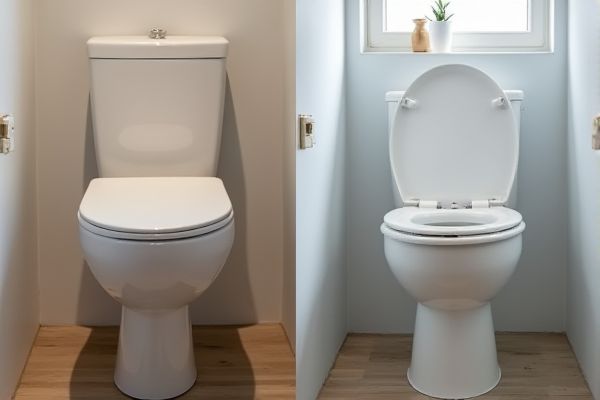
Compact toilets save space with their smaller dimensions, making them ideal for tight bathrooms, while comfort height toilets provide an ergonomic design that eases sitting and standing, benefiting those with mobility issues. Discover which toilet style best suits Your bathroom needs and lifestyle by reading the full article.
Table of Comparison
| Feature | Compact Toilet | Comfort Height Toilet |
|---|---|---|
| Height | 14-15 inches (standard height) | 16-19 inches (taller seat height) |
| Space Efficiency | Ideal for small bathrooms, saves space | Requires more space due to taller design |
| User Comfort | Suitable for children, small adults | Ergonomic, easier for elderly and disabled |
| Installation | Fits in tight spaces, easier to install in compact areas | Standard installation, may need additional space |
| Price | Generally lower cost | Usually higher cost due to comfort features |
| Use Case | Small bathrooms, guest bathrooms | Master bathrooms, accessible bathrooms |
Introduction to Compact and Comfort Height Toilets
Compact toilets are designed for small bathrooms, offering space-saving dimensions without sacrificing functionality. Comfort height toilets feature a taller seat, typically 17 to 19 inches from the floor, enhancing ease of use, especially for seniors or those with mobility issues. Your choice between compact and comfort height toilets should consider both bathroom space and user comfort requirements.
Key Differences Between Compact and Comfort Height Toilets
Compact toilets feature a smaller footprint ideal for tight bathroom spaces, while comfort height toilets stand taller, typically 17 to 19 inches from floor to seat, promoting ease of use and accessibility. Compact models prioritize space-saving dimensions without sacrificing performance, whereas comfort height designs focus on ergonomic seating that reduces strain for elderly or disabled users. Your choice depends on bathroom size and personal comfort needs, balancing space efficiency with user-friendly height.
Space-Saving Benefits of Compact Toilets
Compact toilets offer significant space-saving benefits, making them ideal for small bathrooms or powder rooms where maximizing floor area is essential. Their reduced dimensions allow for more efficient layouts without sacrificing functionality or comfort. You can optimize tight spaces while maintaining modern design and ease of use by choosing a compact toilet.
Ergonomic Advantages of Comfort Height Toilets
Comfort height toilets offer ergonomic advantages by aligning the seat height closer to the natural standing position, typically between 17 to 19 inches, reducing strain on the knees and hips during sitting and standing. This design benefits individuals with mobility challenges, arthritis, or limited flexibility by promoting easier transfers and increasing overall comfort. Compared to compact toilets, which prioritize space-saving but often have lower seat heights, comfort height models enhance accessibility and reduce the risk of joint discomfort.
User Accessibility and ADA Compliance
Compact toilets are designed for smaller spaces while maintaining user accessibility, but may have lower seat heights that can be challenging for individuals with mobility issues. Comfort height toilets typically range from 17 to 19 inches, meeting ADA compliance standards by providing easier sitting and standing for people with disabilities or limited mobility. Choosing a comfort height toilet can enhance your bathroom's accessibility, ensuring it accommodates a wider range of users with improved ergonomics.
Installation Considerations for Both Toilet Types
Compact toilets require careful measurement of your bathroom space to ensure they fit properly, especially in smaller or tighter areas where standard fixtures might be cumbersome. Comfort height toilets, typically 2 to 4 inches taller than standard models, may need adjustments to plumbing and space clearance during installation to maintain ergonomic benefits. Both toilet types demand secure flange positioning and proper sealing to prevent leaks, with potential variations in rough-in measurements that influence your installation process.
Water Efficiency and Performance Comparison
Compact toilets typically use 1.28 gallons per flush (GPF), optimizing water efficiency without sacrificing flushing power, making them ideal for smaller bathrooms. Comfort height toilets feature similar water consumption but often incorporate advanced flushing technologies like pressure-assisted or dual-flush systems, enhancing performance while maintaining eco-friendly standards. Choosing between the two depends on your space constraints and preference for water-saving features versus flushing strength.
Aesthetic and Design Variations
Compact toilets often feature a sleek, space-saving design ideal for smaller bathrooms, emphasizing minimalistic aesthetics without sacrificing functionality. Comfort height toilets are generally taller, providing ergonomic benefits and a more substantial, traditional look that complements larger bathroom spaces. Your choice between these styles can enhance the room's overall ambiance while meeting specific spatial and comfort needs.
Pricing and Long-Term Value
Compact toilets generally have a lower upfront cost, making them an affordable choice for tight budgets or small bathrooms. Comfort height toilets typically cost more but offer enhanced ergonomics, which can reduce strain and improve posture over time, potentially lowering healthcare-related expenses. Investing in a comfort height toilet may provide better long-term value due to its durability and user-friendly design tailored to your comfort.
Choosing the Right Toilet for Your Bathroom Needs
Selecting the right toilet depends on bathroom space and user comfort preferences; compact toilets offer a space-saving solution ideal for small bathrooms, while comfort height toilets provide a taller seat for easier sitting and standing, beneficial for elderly or mobility-impaired users. Compact toilets typically measure around 14-16 inches from floor to seat, fitting tighter spaces without compromising functionality. Comfort height models usually stand 17-19 inches high, aligning with standard chair height to reduce strain and enhance accessibility.
 homyna.com
homyna.com